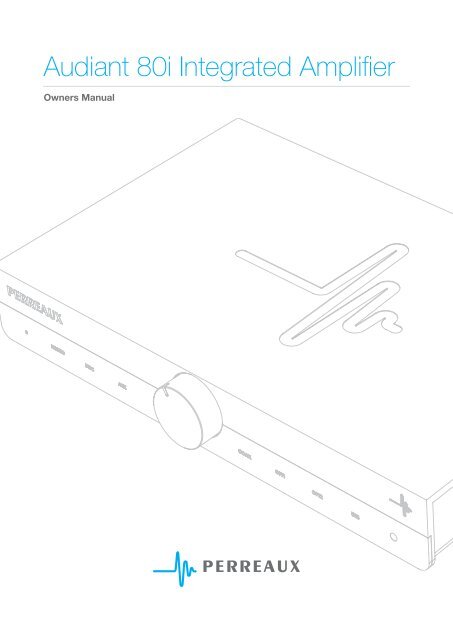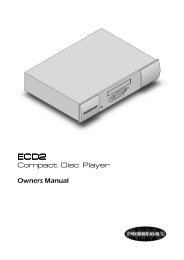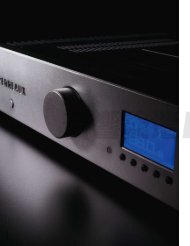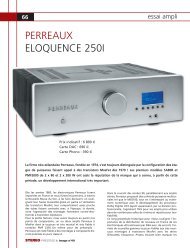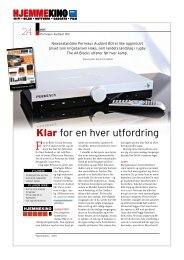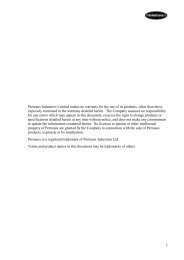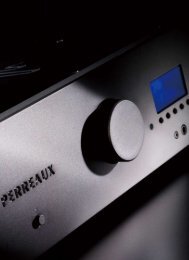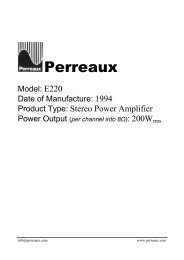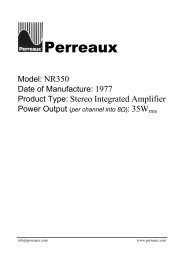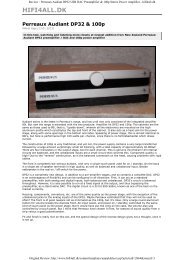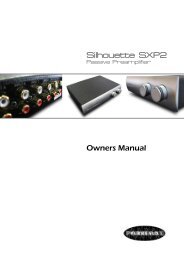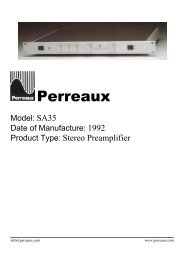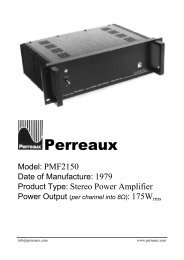Audiant 80i Integrated Amplifier - Perreaux Industries
Audiant 80i Integrated Amplifier - Perreaux Industries
Audiant 80i Integrated Amplifier - Perreaux Industries
You also want an ePaper? Increase the reach of your titles
YUMPU automatically turns print PDFs into web optimized ePapers that Google loves.
<strong>Audiant</strong> <strong>80i</strong> <strong>Integrated</strong> <strong>Amplifier</strong><br />
Owners Manual
Important Safety Instructions<br />
Explanation of symbols used in this manual or on the rear of the device:<br />
This symbol is intended to alert the user to the presence of uninsulated dangerous voltages<br />
within the enclosure of sufficient magnitude to cause electric shock.<br />
This symbol is intended to alert the user to the presence of important operation,<br />
maintenance and servicing information in the instruction and service manuals.<br />
1<br />
Caution<br />
• To reduce the risk of electric shock, do not remove the cover.<br />
• No user serviceable parts inside.<br />
• Refer servicing to qualified service personnel.<br />
• Replace the mains fuse in the plug with one of the same type and rating.<br />
• Disconnect supply cord before changing fuse.<br />
Warning<br />
To reduce the risk of fire or electric shock, do not expose this device to rain or moisture. Shock hazard - do<br />
not open.<br />
Mains Plugs<br />
• This device is supplied with a non-rewireable mains plug for the intended country.<br />
• Replacement mains leads can be obtained from your <strong>Perreaux</strong> dealer. Should you need to change<br />
the plug please dispose of it carefully.<br />
A plug with bared conductors is dangerous if engaged in a live socket.<br />
• The Brown wire must be connected to the Live (Line) supply pin.<br />
• The Blue wire must be connected to the Neutral supply pin.<br />
• The Green/Yellow wire must be connected to the Earth (Ground) supply pin.<br />
• Please contact your dealer or a competent electrician if you are in any doubt.<br />
• Refer to the rear of the product for fuse and mains voltage information.<br />
This product is designed to comply with international directives on the Restriction<br />
of Hazardous Substances (RoHS) in electronic equipment. The wheelie bin logo<br />
indicates compliance and that these products must be recycled or processed as<br />
according to these directives.
General Safety Instructions<br />
All safety and operation instructions should be read carefully before the <strong>80i</strong> is operated. Keep the Owners<br />
Manual in a safe place for future reference.<br />
• Read these instructions.<br />
• Keep these instructions.<br />
• Heed all warnings.<br />
• Follow all instructions.<br />
• Do not use the device near water, for example near a bathtub, kitchen sink, in a wet basement, near a<br />
swimming pool, etc.<br />
• Clean only with a dry cloth.<br />
• Mounting to a wall or ceiling should be via a heavy-duty bracket or shelf designed for audio equipment<br />
use.<br />
• The device should be situated away from heat sources such as radiators, stoves, or other appliances<br />
that produce excessive amounts of heat.<br />
• DO NOT place the device directly onto carpeted surfaces.<br />
• Avoid exposing the device to extremely high or low temperatures.<br />
• The device should be connected to a mains power supply only of the type described in the operating<br />
instructions, and/or as marked on the rear of the unit.<br />
• DO NOT defeat the safety earth of the grounding type mains plug, severe injury or death may result. If<br />
the provided plug does not fit into your outlet, contact your dealer or consult an electrician.<br />
• The power cord should be routed so that it is not likely to be walked on or pinched by items placed on<br />
or against it.<br />
• Unplug the device during lightning storms or when unused for long periods of time.<br />
• DO NOT let objects or liquids fall into the device, expose the device to dripping or splashing or place a<br />
vessel containing liquid on top of the device.<br />
• Keep this device out of reach of children.<br />
• DO NOT operate the device with the cover removed.<br />
• DO NOT bypass any fuse, replace only with the value and type specified.<br />
• DO NOT attempt to repair the device. In the event of a problem, please contact your <strong>Perreaux</strong> dealer.<br />
• DO NOT operate this product in an explosive atmosphere.<br />
2
Table of Contents<br />
INTRODUCTION.......................................................................................................................................3<br />
INSTALLATION.........................................................................................................................................4<br />
CONNECTING..........................................................................................................................................5<br />
Rear Panel...............................................................................................................................................5<br />
OPERATION..............................................................................................................................................7<br />
Front Panel..............................................................................................................................................7<br />
Remote Control.......................................................................................................................................8<br />
PROTECTION SYSTEM...........................................................................................................................9<br />
CARE AND MAINTENANCE.....................................................................................................................9<br />
TROUBLESHOOTING............................................................................................................................10<br />
TECHNICAL SPECIFICATIONS..............................................................................................................11<br />
PHYSICAL DIMENSIONS.......................................................................................................................13<br />
CONTACT DETAILS................................................................................................................................14<br />
Introduction<br />
3<br />
The <strong>Audiant</strong> <strong>80i</strong> integrated amplifier<br />
Congratulations on your <strong>Audiant</strong> <strong>80i</strong> integrated amplifier purchase. To realize the full potential of your unit you need<br />
to appreciate all aspects of its operation.<br />
Before installing the <strong>80i</strong> into your system, read the entire manual carefully. Endeavour to understand every detail<br />
by familiarising yourself with the controls and features as you read. You will find it easier to install using the relevant<br />
sections of this manual as a reference.<br />
We have attempted to explain every feature and operation facet clearly and concisely. Your <strong>Perreaux</strong> dealer will be<br />
happy to assist if you encounter any unforeseen problems.<br />
Read this manual, install your unit correctly and realise the sonic significance of your investment in <strong>Perreaux</strong>.<br />
<strong>Perreaux</strong> products are designed to provide the utmost in sonic realism and electronic reliability, with a functional<br />
yet elegant appearance that reflects the care and craftsmanship applied during all stages of construction.<br />
We maintain the human-link throughout; from design and construction, through to the ultimate test – your music,<br />
your system, your ears.<br />
Because we too listen to our products, we know that with your <strong>Audiant</strong> integrated amplifier you will discover many<br />
more of the musical secrets we strive to reveal.<br />
From all of us at <strong>Perreaux</strong>, thank you for choosing the <strong>Audiant</strong> <strong>80i</strong> integrated amplifier.<br />
Copyright and Acknowledgments<br />
<strong>Audiant</strong> <strong>80i</strong> Manual Version 1.0<br />
Copyright © 2010 <strong>Perreaux</strong> <strong>Industries</strong> Ltd.<br />
<strong>Perreaux</strong> <strong>Industries</strong> Ltd., Gladstone Road, Mosgiel, Dunedin 9024, New Zealand.<br />
All rights reserved. No part of this publication may be reproduced, stored in a retrieval system, or transmitted, in any form or by any means, electronic, mechanical,<br />
photocopying, recording, or otherwise, without the prior written permission of the publisher. The content of this manual is furnished for information use only, is subject<br />
to change without notice, and should not be construed as a commitment by <strong>Perreaux</strong> <strong>Industries</strong> Ltd.<br />
<strong>Perreaux</strong> <strong>Industries</strong> Ltd. assumes no responsibility or liability for any errors or inaccuracies that may appear in this manual.<br />
All trademarks and registered trademarks are the property of their respective owners. <strong>Perreaux</strong>, the <strong>Perreaux</strong> logo and <strong>Audiant</strong> are trademarks of <strong>Perreaux</strong> <strong>Industries</strong><br />
Ltd. All rights reserved. Printed in New Zealand.
Installation<br />
Unpacking<br />
The <strong>Audiant</strong> <strong>80i</strong> is supplied with the following accessories:<br />
• Remote control<br />
• 2 x AAA batteries<br />
• Mains lead<br />
• USB cable<br />
• This manual<br />
We recommend you retain the packaging for reuse in case you need to transport the unit at a later date.<br />
Placement<br />
Your <strong>Audiant</strong> <strong>80i</strong> integrated amplifier should generally be placed close to your primary source component,<br />
keeping interconnect cabling short.<br />
Position all other components of your system close enough to your <strong>80i</strong> to avoid having to stretch or extend<br />
any of the interconnect cables.<br />
Ventilation Requirements<br />
Your <strong>Audiant</strong> <strong>80i</strong> requires dissipating considerable power in the form of heat. It should be placed in a<br />
position that does not restrict the airflow around it.<br />
Allow at least 80mm (3 inches) above and to each side of the unit and mount the <strong>Audiant</strong> <strong>80i</strong> on a flat<br />
surface for air circulation to allow heat to dissipate.<br />
Do not place directly onto a carpeted surface as it will reduce air circulation and the heat will not dissipate<br />
as intended.<br />
It the device is used in a cabinet, air must be able to flow through. An enclosed cabinet will severely restrict<br />
heat dissipation.<br />
Ensure that nothing is placed above or below the amplifier that might block or restrict the vents.<br />
If the <strong>Audiant</strong> <strong>80i</strong> has inadequate ventilation and/or is played very enthusiastically for a period of time, its<br />
temperature may rise above the designated operating level and the over-temperature protection will trip<br />
(see Protection System section).<br />
Other Devices<br />
Ideally, your <strong>Audiant</strong> <strong>80i</strong> integrated amplifier should not be located directly above or adjacent to other heatproducing<br />
products such as radiators, other power amplifiers, etc. If multiple amplifiers are being used and<br />
space is restricted, placing them side by side is preferable to stacking.<br />
Do not place another device directly on top of the <strong>Audiant</strong> <strong>80i</strong>, it will restrict heat dissipation and prevent<br />
the heatsink from operating as designed.<br />
It is advisable to position your <strong>Audiant</strong> <strong>80i</strong> away from (and if possible, connected to a power socket on a<br />
different circuit from) powerful electrical or electronic products such as TV sets, computers, cookers, fridges<br />
etc. This will prevent the possibility of the strong electrical and electromagnetic emissions or interference<br />
given off by such devices adversely affecting the performance of your amplifier.<br />
4
Connecting - Rear panel<br />
15<br />
14<br />
13<br />
12<br />
11<br />
10<br />
9 8<br />
7<br />
6<br />
5<br />
4<br />
3<br />
2<br />
1<br />
Important:<br />
Before making any connections, switch off the mains power to all components in your system.<br />
5<br />
1 Power On/Off<br />
The Power switch turns power to the unit on and off.<br />
2 Mains Power Socket<br />
The Mains Power Socket is used with the removable mains power cord to supply your <strong>Audiant</strong> <strong>80i</strong><br />
integrated amplifier with power.<br />
Before connecting the <strong>80i</strong> to the mains power, please check the voltage label on the rear panel to<br />
ensure that your amplifier conforms to the power supply in your area. Never attempt to connect the<br />
unit to an incorrect voltage – severe damage may result.<br />
Note: The unit must always be earthed when connected to mains power. Use the earthed, moulded<br />
mains lead supplied. Never use an unearthed mains plug, socket or adaptor with this unit. The mains<br />
lead supplied may be fitted with a fused plug, depending on local regulations. If this is the case,<br />
always replace this fuse with another of the same type and rating.<br />
3 Mains Fuse<br />
The mains fuse is user serviceable, and should always be replaced with the same type and rating (see<br />
Technical Specifications, page 11).<br />
Ensure your <strong>Audiant</strong> <strong>80i</strong> is disconnected from the mains power before attempting to change the fuse.<br />
Note: Fuses do not usually blow without a reason. Any doubts about fuse failure should be conveyed<br />
directly to your <strong>Perreaux</strong> dealer.<br />
4 Speaker Outputs<br />
These speaker terminals are for connecting a speaker system. Connect the wires from your left<br />
channel loudspeaker to the LEFT + & - terminals, and the wires from the right channel loudspeaker to the<br />
RIGHT + & - terminals. In each case, the red terminal is the positive output and the black terminal is the<br />
negative output.<br />
Care should be taken to ensure no stray strands of wire short the speaker outputs together. Please<br />
ensure that the loudspeaker terminals have been tightened to provide a good electrical connection. It<br />
is possible for the sound quality to be affected if the screw terminals are loose.
5 Phono Earth Terminal<br />
The phono earth terminal connects to the earth lead from the tonearm cable of a record player, if<br />
required.<br />
6 Phono Input<br />
These sockets are for connecting to an analogue record player. The phono input is only compatible<br />
with moving-magnet (MM) cartridges.<br />
If you wish to use an external phono amplifier, the internal phono stage can be bypassed and used as<br />
a line level input. Ask your <strong>Perreaux</strong> dealer for assistance with bypassing the internal phono stage.<br />
7 Aux, Disc Inputs<br />
These inputs are suitable for any ‘line level’ source equipment such as CD players, DAB or FM/AM tuners<br />
etc.<br />
Note: These inputs are for analogue audio signals only. They should not be connected to the digital<br />
output of a CD player or any other digital device.<br />
8 HT Loop Switch<br />
This switch is used to select the operation of the HT Loop Input.<br />
‘HT’ is selected by default from the factory and bypasses the volume control allowing the <strong>Audiant</strong> <strong>80i</strong><br />
to be integrated into a home theatre system.<br />
Setting to ‘Line’ allows the HT Loop Input to be used as a line level input for analogue sources such as<br />
an iPod or tape deck.<br />
Caution: When connecting a line level signal, make sure the HT Loop Switch is set to ‘Line’, otherwise<br />
serious damage may occur to the amplifier and/or your speakers.<br />
9 HT Loop Input<br />
The Home Theatre Loop is used to integrate the <strong>Audiant</strong> <strong>80i</strong> into a home theatre system that has<br />
preamp outputs on the surround processor or receiver. Please ensure the volume level of the<br />
connected processor is suitably attenuated before selecting this input.<br />
It can also be used as a line level input depending on the setting of the HT Loop Switch.<br />
10 Line Out<br />
These sockets provide a line level audio signal, suitable for recording from the selected source input.<br />
The input should not be changed whilst recording.<br />
11 Pre Out<br />
These sockets provide a preamp level audio signal for connection to an external power amplifier or<br />
active subwoofer.<br />
12 Coax Input<br />
The Coax Input is for connecting coaxial digital sources, such as CD players, music streamers etc.<br />
13 Opt1, Opt2 Inputs<br />
These inputs are for connecting optical digital sources, such as TVs, Sky and Freeview set-top boxes etc.<br />
14 USB Input<br />
The USB Input is for connecting directly to your computer.<br />
When connecting to your computer via USB, the <strong>Audiant</strong> remote control will allow basic control of your<br />
music application, such as iTunes, Windows Media Player etc. (see Remote Control, page 8).<br />
15 RS232 Port<br />
The RS232 port allows external serial control of the <strong>Audiant</strong> <strong>80i</strong> for custom install use. A full command set is<br />
available on the <strong>Perreaux</strong> website. This port can also be used by <strong>Perreaux</strong> service personnel for software updates.<br />
6
Operation - Front Panel<br />
1 2 3<br />
2<br />
4<br />
7<br />
1 Standby Button<br />
The Standby Button switches the unit between Standby mode (indicated by dim standby LED) and On<br />
(indicated by bright standby LED). Standby is a low-power mode where the power consumption is less<br />
than 1 Watt. The unit should be left in Standby mode when not in use.<br />
2 Source Buttons<br />
The Source Buttons allow you to select the source component that you wish to listen to. The signal<br />
selected is also fed to the Line Out sockets so that it may be recorded. The input should not be<br />
changed whilst recording.<br />
3 Volume Control<br />
The Volume Control increases/decreases the level of the sound from the outputs of the amplifier. This<br />
control affects the level of the loudspeaker output and the preamp output. It does not affect the Line<br />
Out connections.<br />
Note: When HT Input (Home Theatre Loop) is selected, and the HT Loop Switch is set to ‘HT’, the<br />
volume control will have no effect on the volume level of the amplifier.<br />
4 Infrared Sensor<br />
The Infrared (IR) Sensor receives commands from the supplied <strong>Audiant</strong> remote control. Clear<br />
unobstructed line of sight between the remote control and the sensor is required.
Operation - Remote Control<br />
1 Standby<br />
The Standby key switches<br />
the amplifier between On<br />
and Standby mode.<br />
2 Source Up & Down<br />
The Source keys scroll<br />
through the source inputs.<br />
3 Volume Up & Down<br />
The Volume keys adjust<br />
the volume level of the<br />
amplifier. When the HT input<br />
(HT Loop) is selected the<br />
Volume keys will have no<br />
effect.<br />
4 Skip Backward<br />
When connected to a<br />
computer using the USB<br />
input, the Skip Backward<br />
key allows you to skip<br />
backward by one track<br />
in the music application<br />
running on the computer.<br />
The USB input must<br />
be selected for this to<br />
function.<br />
5 Play/Pause<br />
When connected to a<br />
computer using the USB<br />
input, the Play/Pause<br />
key allows you to play<br />
and pause the music<br />
application running on the<br />
computer. The USB input<br />
must be selected for this<br />
to function.<br />
9 Mute<br />
The Mute key causes the<br />
volume level of the amplifier<br />
and the preamp outputs to<br />
be muted. The mute mode<br />
is indicated by the selected<br />
input LED flashing gradually.<br />
Press again, or increase the<br />
volume, to cancel mute.<br />
6 Skip Forward<br />
When connected to a<br />
computer using the USB<br />
input, the Skip Forward key<br />
allows you to skip forward<br />
by one track in the music<br />
application running on the<br />
computer. The USB input<br />
must be selected for this to<br />
function.<br />
7 Stop<br />
When connected to a<br />
computer using the USB<br />
input, the Stop key allows<br />
you to stop the music<br />
application running on the<br />
computer. The USB input<br />
must be selected for this to<br />
function.<br />
8 Display<br />
The Display key adjusts the<br />
display options, scrolling<br />
through FULL, MEDIUM<br />
and LOW brightness and<br />
display OFF, although the<br />
Standby LED will remain on<br />
at a reduced brightness. If<br />
the display is set to OFF, the<br />
display will turn on when the<br />
source input is changed then<br />
automatically turn off.<br />
8<br />
10 Direct Source Keys<br />
The Direct Source Keys<br />
provide direct selection of<br />
source inputs.
9<br />
Protection System<br />
Your <strong>Audiant</strong> <strong>80i</strong> integrated amplifier protection systems to ensure reliability and long life of the unit and<br />
the speakers it is connected to. The protection system comprises of five main protection methods. In all<br />
instances the protection state will be indicated by all source input LEDs flashing. Power to the amplifier will<br />
need to be cycled, by the standby button or power switch, to reset the protection state.<br />
DC Offset Detection<br />
The DC offset detection system offers loudspeaker protection if the output of the amplifier goes to a high<br />
DC voltage.<br />
Over-Temperature Detection<br />
The over-temperature detection system constantly monitors the heat generated by the output MOSFETs.<br />
If the monitored temperature reaches 80°C (176°F) the output to the speakers will be disconnected to stop<br />
the temperature from rising further.<br />
An over-temperature condition is normally caused by a combination of high listening levels, low impedance<br />
or low sensitivity speakers.<br />
Fuse Fail Detection<br />
The fuse fail detection system monitors the internal DC rail fuses. If any of the fuses should blow the output<br />
to the speakers will be disconnected to protect the speakers and amplifier from damage.<br />
Fuses normally blow for a reason. Any doubts about fuse failure should be conveyed directly to your<br />
<strong>Perreaux</strong> dealer.<br />
AC Fail Detection<br />
The AC fail detection system monitors the AC voltage on the main power transformer. If for any reason<br />
the AC mains voltage is lost, e.g. power failure or tripped circuit breaker, the speakers are immediately<br />
disconnected from the amplifier before the amplifier loses power.<br />
Over-Current Detection<br />
The over-current detection system ensures the output devices are constantly operating within their safe<br />
operating limits and provides a fast response to temporary overload conditions. When an over-current condition<br />
is detected the output to the speakers is disconnected to isolate the amplifier from potential damage.<br />
An over-current condition can occur due to a short across the speaker terminals, a speaker driver/crossover<br />
fault or excessive current demand due to low impedance speakers.<br />
Care and Maintenance<br />
The <strong>80i</strong> has been designed to provide many years of trouble free enjoyment. It is important to keep the<br />
exterior of the unit clean.<br />
Notes: Always switch the unit off and remove the power cord from the rear of the amplifier before<br />
attempting to clean your <strong>Audiant</strong> <strong>80i</strong> integrated amplifier in the manner described below.<br />
Never apply liquid directly to the amplifier.<br />
Never use abrasives.<br />
Never rub in a circular motion.<br />
Front Panel and Cover<br />
The front panel and cover feature a durable, high-quality anodised finish. To remove finger marks and dirt,<br />
simply rub the surface with a soft cloth.<br />
If the dirt is not removed, use a small quantity of isopropyl alcohol on a clean cloth and rework the effected area.
Troubleshooting<br />
There is no power<br />
Ensure the AC power cord is connected securely.<br />
Ensure the mains plug is fully inserted into the wall socket and is switched on.<br />
Check the mains fuse of the amplifier.<br />
Check fuse in the mains plug or adaptor.<br />
There is no sound<br />
Check that the source component is properly connected.<br />
Check that the source component playing.<br />
Check that the speakers are properly connected.<br />
Make sure the amplifier is not muted.<br />
There is no sound on one channel<br />
Check speaker connections.<br />
Check interconnects.<br />
There is a loud buzz or hum<br />
Ensure no interconnects are loose or defective.<br />
Ensure that your tape deck/turntable is not too close to the amplifier.<br />
Unable to make or play tape recordings<br />
Check Line Out has been connected correctly.<br />
There is weak bass or diffused stereo imaging<br />
Ensure the speakers are wired in the correct polarity, the +ve terminal of the loudspeaker should connect to<br />
the +ve speaker output terminal of the amplifier, and likewise, -ve to -ve.<br />
All source LEDs are flashing<br />
The protection system of the amplifier has engaged (see Protection System section).<br />
The remote handset will not function<br />
Check the batteries have not expired.<br />
Check the batteries are inserted in the correct orientation.<br />
Ensure that nothing is blocking the remote sensor.<br />
10
Technical Specifications<br />
All specifications are accurate at the time of printing. <strong>Perreaux</strong> <strong>Industries</strong> Ltd. reserves the right to adjust<br />
specifications without notice.<br />
All specifications measured at 230V after a 10 minute warm up period using an Audio Precision ATS-2<br />
Audio Analyser. Measurements taken at 65kHz bandwidth, unless specified otherwise. Digital to analogue<br />
converter measurements taken using 24-bit/96kHz input signal.<br />
11<br />
<strong>Amplifier</strong><br />
Rated Power Output (per channel,
Digital to Analogue Converter (DAC)<br />
Input Sample Rate (maximum):<br />
Input Word Length (maximum):<br />
Digital to Analogue Conversion:<br />
Output Voltage:<br />
Total Harmonic Distortion (THD+N)<br />
Typically:<br />
20Hz to 20kHz:<br />
Frequency Response:<br />
Signal to Noise Ratio (A-weighted):<br />
96kHz (Coax, Optical)<br />
48kHz (USB)<br />
24-bit (Coax, Optical)<br />
16-bit (USB)<br />
24-bit/96kHz (upsampled)<br />
1.95Vrms @ 0dBFS<br />
0.002% @ 1kHz, -20dBFS<br />
Dimensions<br />
67mm (2.6”)<br />
431mm (17.0”)<br />
13<br />
309mm<br />
(12.2”)
Installation Notes<br />
Please record the serial number of your <strong>Audiant</strong> <strong>80i</strong> integrated amplifier for future reference.<br />
Serial Number: __________________________<br />
_____________________________________________________________________________________________________<br />
_____________________________________________________________________________________________________<br />
_____________________________________________________________________________________________________<br />
_____________________________________________________________________________________________________<br />
_____________________________________________________________________________________________________<br />
_____________________________________________________________________________________________________<br />
_____________________________________________________________________________________________________<br />
_____________________________________________________________________________________________________<br />
_____________________________________________________________________________________________________<br />
_____________________________________________________________________________________________________<br />
14<br />
Contact Details<br />
<strong>Perreaux</strong> <strong>Industries</strong> Ltd.<br />
PO Box 305<br />
Mosgiel<br />
Dunedin 9053<br />
New Zealand<br />
T: +64 3 489 2975<br />
F: +64 3 489 2976<br />
E: nz.info@perreaux.com<br />
W: www.perreaux.com
<strong>Perreaux</strong> <strong>Industries</strong> Ltd.<br />
PO Box 305<br />
Mosgiel<br />
Dunedin 9053<br />
New Zealand<br />
T: +64 3 489 2975<br />
F: +64 3 489 2976<br />
E: nz.info@perreaux.com<br />
W: www.perreaux.com


